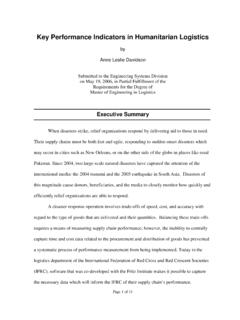Transcription of Humanitarian Logistics: Enabling Disaster …
1 Humanitarian relief organizations (HROs) coordinate billions of dollars in relief annually to victims of natural disasters, civil conflict and war. Their chief task is the timely mobilization of financing and goods from international donors and administering relief to vulnerable ben- eficiaries at Disaster sites across the globe. As such, logistics is central to their activities and strategic to their missions. Our research has shown, however, that environmental factors, such as the unpredictability of disasters, and the nature of funding have resulted in logistics opera- tions with high employee turnover rates, fragmented technology, poorly-defined manual processes, and a lack of institutional learning over time.
2 As a consequence, the role and sig- nificance of logistics is not well understood or appreciated in most HROs or by the donors who provide the financial support for relief. Humanitarian logistics : Enabling Disaster response , fritz Institute 1. fritz Institute is a non-profit based in San Francisco whose mission is to strengthen the infrastructures of Humanitarian relief organizations by mobilizing logistics and technology expertise and resources from the corporate and academic communities. This position paper provides background on the current state of logis- tics in the Humanitarian environment and the factors that have limited the evolution of knowledge and the per- formance of supply chains for Humanitarian relief.
3 The paper then describes the approaches that fritz Institute feels can move the field forward. Humanitarian logistics has much in common with corporate logistics , yet the best practices from the corpo- rate world, or from other Humanitarian organizations in many cases, have not crossed over. It is paradoxical that a sector which has such extreme requirements in terms of timeliness, affordability and oversight is so underdeveloped. It is precisely this paradox that creates what we see as a great opportunity for advancement of the field and of the Humanitarian mission. The views presented here are based on extensive research conducted by fritz Institute over the past year.
4 Our team spent over 3,000 hours interviewing the entire logistics team, as well as key functions that interact close- ly with logistics such as desk officers, operations managers, finance and IT at the International Federation of Red Cross and Red Crescent Societies (IFRC) as part of a requirements gathering exercise for the develop- ment of a new logistics information software. Subsequently we visited 12 leading Humanitarian relief organ- izations (see Table 1) at their headquarters and in the field, to understand and map their relief logistics processes. Finally, we brought the heads of logistics of these and other HROs together with leading supply chain professors at a Humanitarian logistics Conference for two days to discuss the research, validate our results about their pain points, and give input to the path forward 1.
5 Table 1: Snapshot of Select Humanitarian Organizations Name of Organization Total Contributions Total Contributions 2 Countries of 2000 (US$) 1 2001 (US$) Operation 3. American Red Cross 4 $ $ 38. CAR E USA 60. Catholic Relief Services 92. International Committee of the Red Cross 80. International Federation of Red Cross and 178. Red Crescent Societies International Rescue Committee 28. Medecins San Frontiers - Belgium 42. Oxfam U K 75. Save the Children 45. U N ICE F 126. World Food Programme 5 82. World Vision International 6 96. $ $ Notes: Source: Primary research with organizations and published annual reports (1) Shown in dollars. Exchange rates from US $ to Euros as of year-end for 2000 is $1 = Euros, and for 2001 is $1 = Euros.
6 Source: I M F. (2) Contributions refers to donations to Humanitarian organizations by governments, foundations, other Humanitarian organizations, individuals, and the private sector (3) As per most recent annual report (4) American Red Cross total contributions exclude revenue from products and services (5) World Food Programme receives 54% of food contributions in the form of G I K. (6) World Vision International's 2000 financial statements are not available online. WV USA's contributions for 2000 totaled $ 1 Humanitarian logistics Council meeting, Geneva, January 30-31, 2003. A list of participating organizations at this meeting is provided in Appendix 1.
7 Humanitarian logistics : Enabling Disaster response , fritz Institute 2. The Scope and Importance of Humanitarian logistics Humanitarian logistics refers to the processes and systems involved in mobilizing people, resources, skills and knowledge to help vulnerable people affected by natural disasters and complex emergencies. Humanitarian logistics encompasses a range of activities, including procurement, transport, tracking and trac- ing, customs clearance, local transportation, warehousing and last mile delivery (see Figure 1). logistics is central to Disaster relief for several reasons. First, it serves as a bridge between Disaster pre- paredness and response , between procurement and distribution, and between headquarters and the field.
8 Second, it is crucial to the effectiveness and speed of response for major Humanitarian programs, such as health, food, shelter, water and sanitation. It can be one of the most expensive parts of a relief effort. Third, since the logistics department handles tracking of goods through the supply chain, it is often the repository of data that can be analyzed to provide post-event learning. logistics data reflects all aspects of execution, from the effectiveness of suppliers and transportation providers, to the cost and timeliness of response , to the appro- priateness of donated goods and the management of information. Thus, it is critical to the performance of both current and future operations and programs.
9 Figure 1. The Supply Chain for Humanitarian Relief Assessment/ Resource Transportation Tracking & Stock/Asset Extended Point Performance Preparedness Procurement Appeals Mobilization Execution Tracing Management of Delivery Evaluation Humanitarian Organizations and their Missions Every year, there are approximately 150,000 deaths and 200 million people affected by natural disasters and Humanitarian crises. Natural disasters alone, which include events such as earthquakes, famines and floods, result in the temporary displacement of approximately five million people. The number of displaced people from Humanitarian crises such as civil conflict and war is even larger, with an average of 13 million refugees and 20 million internally displaced people each year.
10 As the relief arm of the global community, humanitar- ian organizations are the front line of assistance for people affected by natural and complex emergencies. Humanitarian organizations, whose missions center on minimizing loss of life and alleviating suffering, are the primary vehicle through which governments channel as much as $6 billion in annual aid2. Complementing government donations to Humanitarian organizations are contributions from foundations, individuals, and the private sector. The Humanitarian organizations receiving donations from this global community include enti- ties operating under the United Nations umbrella such as the World Health Organization (WHO) and the United Nations High Commissioner for Refugees (UNHCR), international organizations such as the International Federation of Red Cross and Red Crescent Societies (IFRC), and global non-governmental organizations (NGOs) like CARE and World Vision, as well as regional and country-specific NGOs3.




